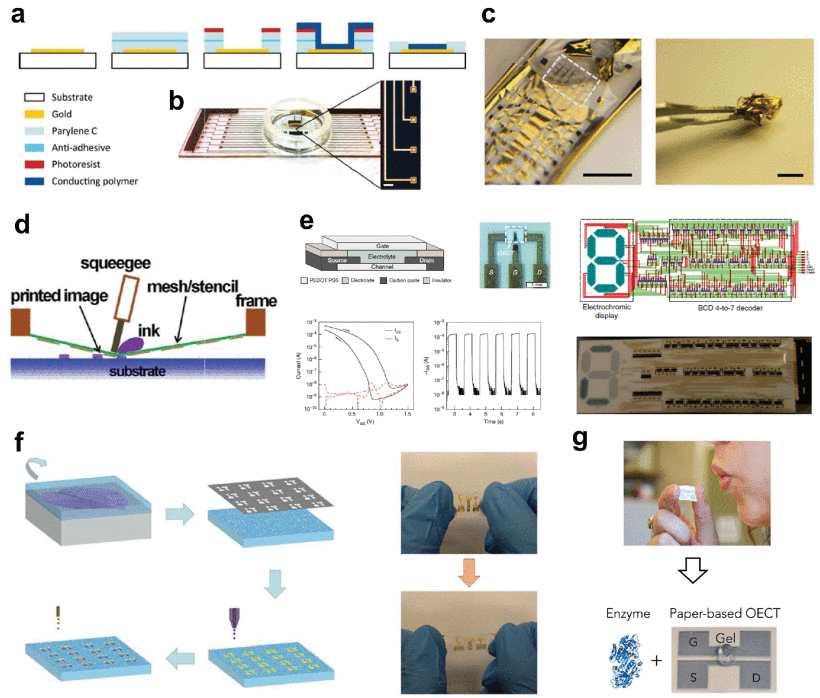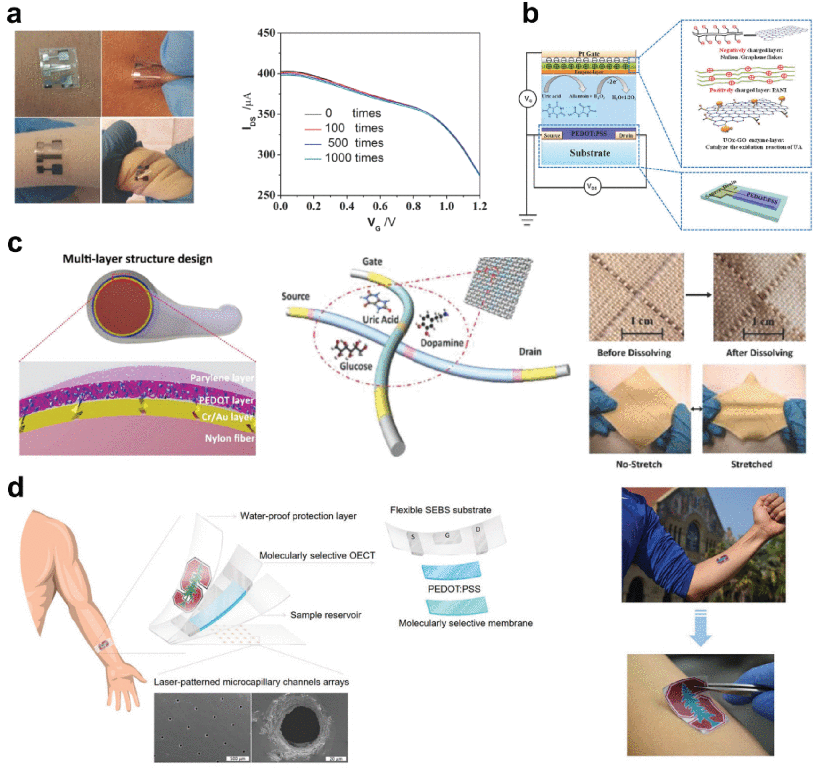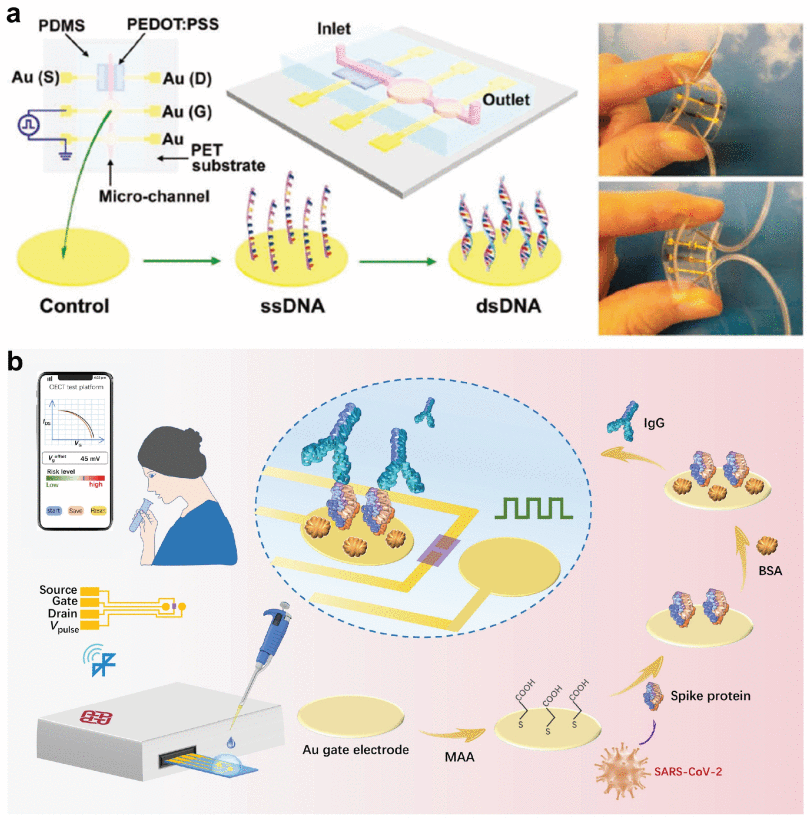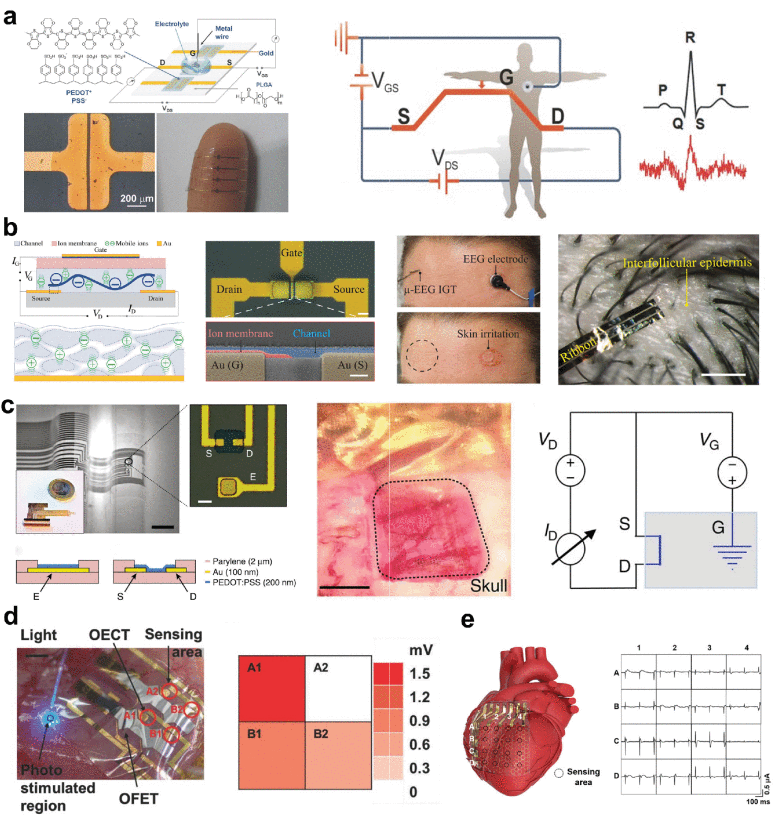Applications of Organic Electrochemical Transistors in Flexible Bioelectronics
Abstract:
Flexible bioelectronics, offering soft functionalized interfaces to couple biology and electronics, have gained increasing interest due to its great promise in personalized health monitoring, point-of-care diagnosis, and the Internet of Things (IoT). Organic electrochemical transistors (OECTs), capable of mixed ionic-electronic transport, have been widely implemented in flexible bioelectronics due to their flexibility, biocompatibility, high transconductance, low working voltage, design diversity, and facile manufacturing. In this review, we focus on the representative bioelectronic applications of flexible OECTs. We first introduce the device physics of OECTs, with a highlight on their identifying features compared to conventional field-effect transistors. Then, the state-of-the-art channel materials used in OECTs are summarized, with discussions on their figures of merit. Followed by an introduction to the main techniques employed for fabricating flexible OECTs, we examine the up-to-date progress in flexible OECTs for bioelectronic applications, including diverse biosensors, electrophysiological monitoring, and neuromorphic devices. Accompanied by a concise summary, the challenges and opportunities in the commercialization of flexible OECTs are discussed.
(a) Typical device architecture of an OECT. (b) Electronic circuit and ionic circuit in OECTs. (c) Potential distribution in the ionic circuit of OECTs.

Fabrication techniques for flexible OECTs. (a) Photolithography-based process for the patterning of conducting polymers [61]. (b) Fabrication of conducting polymers microelectrode arrays on a rigid substrate by using photolithography [61]. (c) Flexible OECTs fabricated by using photolithography [8]. (d) Illustration of the screen printing process [63]. (e) All-printed circuits based on OECTs [64]. (f) Fabrication of OECTs on a stretchable PDMS substrate by using inkjet printing [65]. (g) Paper-based OECT fabricated by using inkjet printing [66].

Flexible OECTs for metabolite detection. (a) Flexible OECTs attached on deformable surfaces and the transfer characteristics before and after bending tests [17]. (b) Highly selective enzyme sensors based on flexible OECTs with bilayer-modified gate electrodes [17]. (c) Fabric OECTs for wearable biosensors [18]. (d) Wearable OECTs integrated with molecularly selective membranes for cortisol detection in sweat [19].

Flexible OECTs for DNA and protein sensors. (a) Label-free DNA sensors based on OECTs incorporated in flexible microfluidic systems [22]. (b) OECT-based portable sensing platform for SARS-CoV-2 IgG detection [23].

Flexible OECTs for electrophysiological monitoring. (a) Flexible OECTs for human ECG recording [74]. (b) Internal ion-gated OECTs for comfortable EEG recording [35]. (c) Flexible OECTs for in vivo monitoring of brain activity [77]. (d) OECT-OFET integrated device arrays for in vivo mapping of electromyogram signals [78]. (e) Stretchable OECT arrays for in vivo ECG mapping of rats [62].

Neuromorphic devices based on OECTs. (a) OECT-based synaptic devices with STP [84]. (b) Nonvolatile synaptic OECTs based on PEDOT:Tos/PTHF [87]. (c) Implementation of OECT-based synaptic devices in a robot [90].

P. C. Hütter, T. Rothländer, G. Scheipl and B. Stadlober, "All Screen-Printed Logic Gates Based on Organic Electrochemical Transistors," in IEEE Transactions on Electron Devices, vol. 62, no. 12, pp. 4231-4236, Dec. 2015.
doi: 10.1109/TED.2015.2491342
keywords: {Logic gates;Electrochemical devices;Resistors;Transistors;Printed circuits;Logic circuits;Organic electronics;Organic electrochemical transistor (OECT);poly(3;4-ethylenedioxithiophene) poly(styrenesulfonate) (PEDOT:PSS);printed logic circuit;screen printing.;Organic electrochemical transistor (OECT);poly(3,4-ethylenedioxithiophene) poly(styrenesulfonate) (PEDOT:PSS);printed logic circuit;screen printing},
URL: http://ieeexplore.ieee.org/stamp/stamp.jsp?tp=&arnumber=7310877&isnumber=7331113


